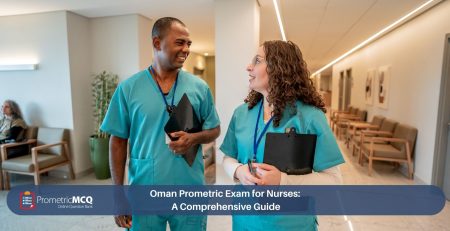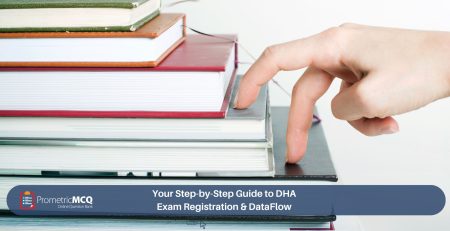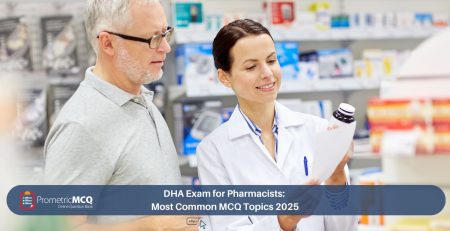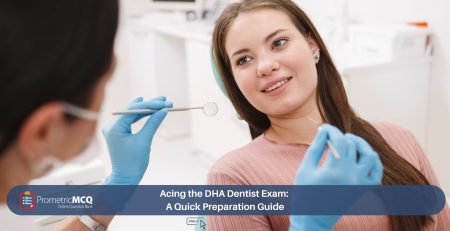
OMSB Oman Exam for Lab Technicians: Pattern and MCQs
fatima@prometricmcq.com2025-09-26T19:03:10+00:00Table of Contents
ToggleOMSB Oman Exam for Lab Technicians: Pattern and MCQs (2025)
The Sultanate of Oman, with its rapidly growing and modernizing healthcare sector, presents a wealth of opportunities for skilled medical laboratory technicians. The Oman Medical Specialty Board (OMSB) ensures that all professionals entering this vital field meet a high standard of competence, knowledge, and dedication to quality. The gateway to a professional career in Oman is the OMSB Prometric exam for Lab Technicians—a comprehensive test designed to validate your skills against international best practices.
This is not a simple knowledge-recall examination. The OMSB exam is a sophisticated, scenario-based test that evaluates your ability to apply theoretical knowledge to practical laboratory situations. It assesses your critical thinking, problem-solving skills, and understanding of quality assurance and patient safety. Success demands more than just studying textbooks; it requires a strategic approach centered on understanding the exam pattern and mastering the art of answering Multiple-Choice Questions (MCQs).
This ultimate 2025 guide has been meticulously developed to serve as your definitive resource for the OMSB Lab Technician exam. We will deconstruct the exam pattern, provide a deep dive into the high-yield syllabus topics across all laboratory disciplines, and offer a valuable set of sample MCQs with detailed, explanatory answers. This practical content is supported by a comprehensive 10-point FAQ section to provide clarity on every step of your preparation journey. Our goal is to equip you with the knowledge and confidence needed to excel in the exam and secure your Oman OMSB License.
Key Takeaways for the OMSB Lab Technician Exam
- It’s About Application, Not Just Theory: The exam focuses on your ability to interpret results, troubleshoot issues, and make sound judgments in clinical scenarios.
- Quality Control is Key: A significant portion of the exam tests your understanding of quality assurance, quality control (QC), and laboratory safety protocols.
- Master the Core Disciplines: Be prepared for an even distribution of questions from Hematology, Clinical Chemistry, Microbiology, and Blood Banking.
- Interpret, Don’t Just Identify: You’ll be expected to correlate lab results with specific disease states and understand the clinical significance of your findings.
- MCQ Practice is Non-Negotiable: The most effective preparation method is to consistently solve high-quality, exam-style MCQs to master the content and timing.
Deconstructing the 2025 OMSB Exam Pattern for Lab Technicians
A successful study campaign starts with a clear understanding of the exam’s architecture. The OMSB exam for Lab Technicians follows a standardized international format, making it predictable for the well-prepared candidate. For a broader overview, you can review our general guide on OMSB Oman Prometric exam preparation.
1. Test Administrator and Format
The OMSB partners with Prometric to conduct its licensure exams worldwide. The exam is a Computer-Based Test (CBT) composed entirely of MCQs.
- Structure: 100 MCQs.
- Duration: 2.5 hours (150 minutes). This gives you exactly 1 minute and 30 seconds per question, a pace that allows for careful consideration of each scenario.
2. Scoring and Outcome
The result is a straightforward Pass/Fail. The OMSB does not provide a numerical score. The unofficial passing threshold is generally considered to be around 60%. Critically, there is no negative marking, so you must answer every question.
3. Question Style: The Clinical Laboratory Scenario
Questions are designed to simulate the daily challenges of a medical laboratory. You may be presented with a set of lab results, a description of a stained slide, a quality control issue, or a pre-analytical problem (e.g., a hemolyzed sample) and asked to determine the cause, interpretation, or next best step.
The OMSB Lab Technician Syllabus: A High-Yield Breakdown
Your study plan must be focused and efficient. The syllabus is broad, but questions are typically distributed across these core laboratory disciplines. Allocating your time proportionally to these areas is a smart strategy.
| Core Laboratory Discipline | High-Yield Topics and Key Concepts for 2025 |
|---|---|
| Clinical Chemistry | This is a major section. Focus on organ function panels (liver, renal, cardiac), endocrinology (thyroid, hormones), electrolytes, blood gases, glucose metabolism (including diabetes diagnosis and monitoring), and therapeutic drug monitoring. Understanding the principles of spectrophotometry and other analytical methods is also key. |
| Hematology & Coagulation | Complete Blood Count (CBC) interpretation, RBC indices, WBC differential and morphology, and identification of anemias (iron deficiency, megaloblastic, hemolytic). Coagulation studies (PT, aPTT, INR) and understanding the coagulation cascade are crucial. Body fluid analysis (CSF, synovial) is also included. |
| Microbiology & Parasitology | Bacteriology (specimen processing, culture media, Gram stain, biochemical identification of common pathogens). Parasitology (identification of common intestinal and blood parasites). Mycology and Virology basics are also fair game. Focus on organisms of clinical significance. |
| Blood Banking (Immunohematology) | ABO/Rh typing (forward and reverse), antibody screening and identification, compatibility testing (crossmatching), transfusion reactions, and blood component therapy. A thorough understanding of the Coombs test (DAT and IAT) is essential. |
| Immunology & Serology | Principles of antigen-antibody reactions, immunoassay techniques (ELISA, chemiluminescence), and serological testing for infectious diseases (e.g., HIV, Hepatitis B/C, Syphilis). |
| Laboratory Operations & Quality Management | This is a critical, overarching theme. Topics include quality assurance vs. quality control (QA/QC), interpreting Levey-Jennings charts, Westgard rules, laboratory safety (universal precautions, chemical safety), and managing pre-analytical variables (e.g., hemolysis, icterus, lipemia). |
Free OMSB Lab Technician MCQs with In-Depth Answers
The best way to solidify your knowledge is to apply it. The following sample questions are designed to mirror the style and difficulty of the real OMSB exam. For a more exhaustive collection, a dedicated question bank for the OMSB Medical Laboratory Exam is your most valuable asset.
Question 1: Clinical Chemistry
A patient’s routine chemistry panel shows the following results:
- Sodium: 140 mmol/L
- Potassium: 4.0 mmol/L
- Chloride: 100 mmol/L
- Bicarbonate (HCO3-): 15 mmol/L
What is the calculated anion gap, and what condition does it suggest?
- 15; Normal anion gap acidosis
- 25; High anion gap metabolic acidosis
- 10; Respiratory alkalosis
- 35; High anion gap metabolic alkalosis
Correct Answer: B (25; High anion gap metabolic acidosis)
Rationale: The anion gap is calculated using the formula: AG = Na+ – (Cl- + HCO3-).
In this case: AG = 140 – (100 + 15) = 140 – 115 = 25 mmol/L.
A normal anion gap is typically 8-16 mmol/L. A value of 25 is significantly elevated. A high anion gap combined with a low bicarbonate level (15 mmol/L, normal is ~24) is the classic finding for a high anion gap metabolic acidosis (HAGMA). This condition is often caused by conditions that produce excess unmeasured anions, commonly remembered by the mnemonic MUDPILES (Methanol, Uremia, DKA, Propylene glycol, Isoniazid, Lactic acidosis, Ethylene glycol, Salicylates).
Why other options are incorrect:
A: The calculation is incorrect, and a normal anion gap acidosis would have a normal AG with low bicarbonate.
C: The calculation is incorrect, and the lab values are inconsistent with respiratory alkalosis (which would typically show low CO2 and slightly low bicarbonate).
D: The calculation is incorrect, and metabolic alkalosis involves a high bicarbonate level.
Question 2: Hematology
A peripheral blood smear from a patient with severe anemia shows numerous schistocytes, polychromasia, and a low platelet count. The patient’s PT and aPTT are normal. These findings are most characteristic of which condition?
- Iron Deficiency Anemia
- Disseminated Intravascular Coagulation (DIC)
- Thrombotic Thrombocytopenic Purpura (TTP)
- Aplastic Anemia
Correct Answer: C (Thrombotic Thrombocytopenic Purpura – TTP)
Rationale: This is a classic presentation of a microangiopathic hemolytic anemia (MAHA). Schistocytes (fragmented RBCs) are the hallmark of MAHA, where red cells are sheared as they pass through fibrin-clogged small blood vessels. The combination of MAHA and severe thrombocytopenia (low platelets) with normal coagulation studies (PT/aPTT) points specifically to TTP. In contrast, DIC would present with prolonged PT and aPTT as coagulation factors are consumed.
Why other options are incorrect:
A: Iron deficiency anemia would show microcytic, hypochromic RBCs, not schistocytes.
B: DIC involves schistocytes and thrombocytopenia, but it is a consumptive coagulopathy, so the PT and aPTT would be prolonged.
D: Aplastic anemia is characterized by pancytopenia (low RBCs, WBCs, and platelets) due to bone marrow failure, but the cell morphology would be normal.
Question 3: Laboratory Operations (QC)
A Levey-Jennings chart for a chemistry control shows that the last seven consecutive data points are all on the same side of the mean, but are still within the ±2 SD limits. According to Westgard rules, what is this rule violation called and what type of error does it indicate?
- 1-3s; Random error
- 2-2s; Systemic error
- R-4s; Random error
- 7-T; Systemic error
Correct Answer: D (7-T; Systemic error)
Rationale: The “7-T” (or 7x) Westgard rule is violated when seven consecutive control measurements all fall on one side of the mean. This is also known as a “trend” or “shift.” It is a classic indicator of a systemic error—a consistent, predictable error in the analytical system. This could be due to issues like a deteriorating reagent, a change in calibrator lot, or an instrument malfunction. Random errors, by contrast, are unpredictable and show no pattern (e.g., a single point outside ±3 SD).
Frequently Asked Questions (FAQs) for the OMSB Lab Tech Exam
The OMSB provides a Pass/Fail result and does not disclose an exact percentage. The accepted unofficial passing standard is approximately 60%. To ensure success, you should aim for scores of 70% or higher on your practice tests.
The OMSB exam is a licensing exam focused on ensuring competency for generalist practice in Oman. It covers all core lab areas. While it draws from the same body of knowledge as certification exams like the ASCP (American Society for Clinical Pathology), it is not an adaptive test. The ASCP exam is computer-adaptive, meaning the difficulty of questions changes based on your answers. The OMSB exam has a fixed set of 100 questions for all candidates.
No, the exam is based on international laboratory standards, best practices, and globally relevant diseases. Your preparation should be based on standard international textbooks and guidelines from organizations like the Clinical and Laboratory Standards Institute (CLSI).
A very high emphasis. You must have a strong understanding of QC principles, including interpreting Levey-Jennings charts, knowing the Westgard rules, and differentiating between random and systemic errors. These topics are guaranteed to appear on the exam.
Primary Source Verification (PSV) is a mandatory credential check performed by the DataFlow Group. They will verify your education, license, and experience directly with the issuing institutions. You must have a positive PSV report before the OMSB will issue your license to practice.
While standard textbooks (like Henry’s or Tietz) are essential for knowledge, the most effective preparation tool is a high-quality question bank (QBank) with practice MCQs. This active learning approach is superior for mastering the content and getting used to the exam format. A dedicated resource for Medical Laboratory MCQs is highly recommended.
The OMSB typically allows a candidate three attempts to pass their licensing exam. There is usually a waiting period between attempts. A failure should prompt a serious re-evaluation of your study strategy, with a much greater focus on solving and understanding MCQs.
While you should know the general direction of change for key analytes in various diseases (e.g., AST/ALT are high in hepatitis), you are not usually required to memorize exact numerical reference ranges. Questions will typically provide the normal range or describe a result as “markedly elevated” or “decreased.”
Yes, it is possible and common for the exam to include images. You may see photomicrographs of peripheral blood smears (to identify abnormal cells), Gram stains (to identify bacteria morphology), or parasites. Your preparation should include reviewing images from a good hematology or microbiology atlas.
With 150 minutes for 100 questions, you have 1.5 minutes per question. This is a generous amount of time. A good strategy is to go through the entire exam once, answering all the questions you are confident about. Flag the ones you are unsure of. Then, use your remaining time to go back and carefully review the flagged questions. This ensures you don’t get stuck on a difficult question and miss out on easier points later.
Conclusion: Your Path to a Laboratory Career in Oman
The OMSB Prometric exam for Lab Technicians is a rigorous test of your professional competence, designed to ensure the highest standards of laboratory practice in Oman. It is a challenge that can be confidently overcome with a disciplined, strategic, and active approach to studying. By understanding the exam’s pattern, focusing on the high-yield syllabus topics, and dedicating yourself to practicing with realistic MCQs, you can build the knowledge and skills necessary to pass. Success in this exam is your key to a rewarding and impactful career in Oman’s thriving healthcare sector.
Ready to Validate Your Skills and Ace the OMSB Exam?
Our comprehensive MCQ package for Medical Laboratory Technicians is filled with high-yield questions, detailed, explanatory answers, and realistic practice exams designed to cover the entire OMSB syllabus and guarantee your success.










